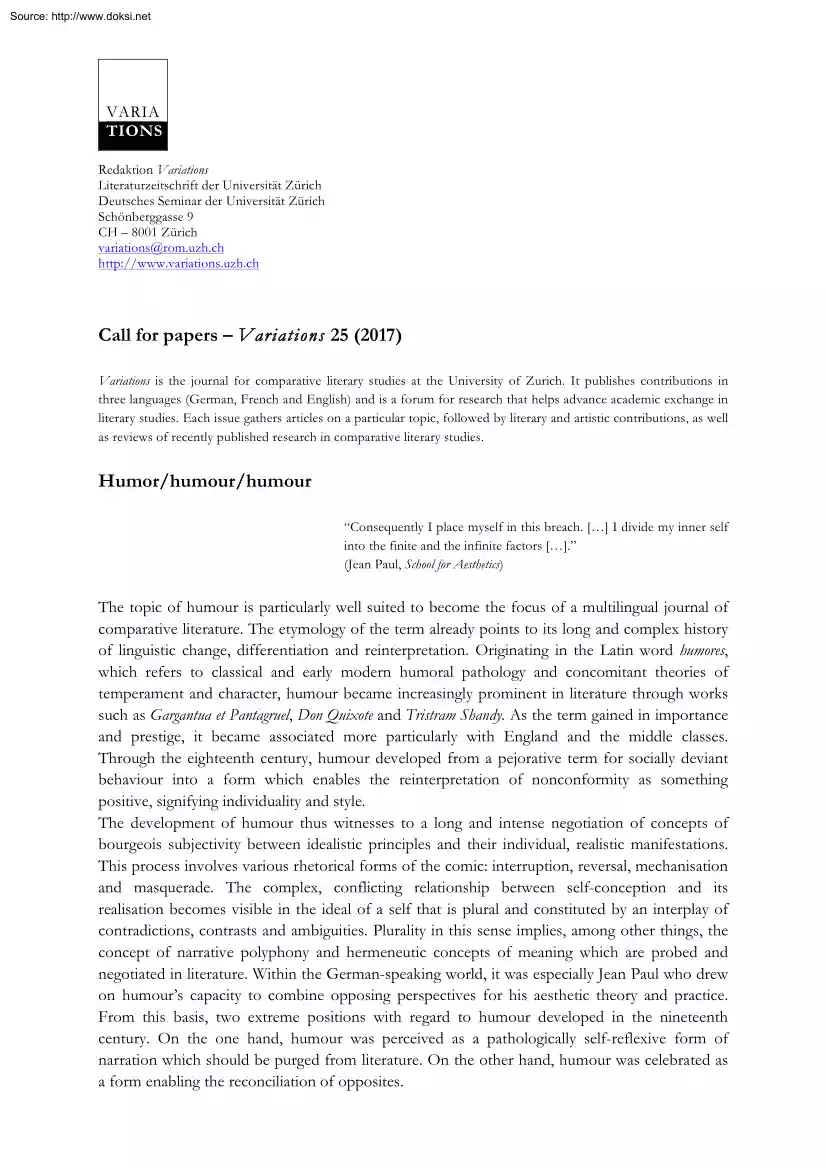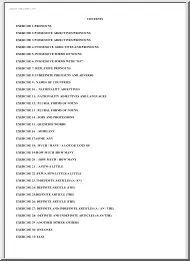Please log in to read this in our online viewer!

Please log in to read this in our online viewer!
No comments yet. You can be the first!
Content extract
Source: http://www.doksinet VARIA TIONS Redaktion Variations Literaturzeitschrift der Universität Zürich Deutsches Seminar der Universität Zürich Schönberggasse 9 CH – 8001 Zürich variations@rom.uzhch http://www.variationsuzhch Call for papers – Variations 25 (2017) Variations is the journal for comparative literary studies at the University of Zurich. It publishes contributions in three languages (German, French and English) and is a forum for research that helps advance academic exchange in literary studies. Each issue gathers articles on a particular topic, followed by literary and artistic contributions, as well as reviews of recently published research in comparative literary studies. Humor/humour/humour “Consequently I place myself in this breach. [] I divide my inner self into the finite and the infinite factors [].” (Jean Paul, School for Aesthetics) The topic of humour is particularly well suited to become the focus of a multilingual journal of comparative
literature. The etymology of the term already points to its long and complex history of linguistic change, differentiation and reinterpretation. Originating in the Latin word humores, which refers to classical and early modern humoral pathology and concomitant theories of temperament and character, humour became increasingly prominent in literature through works such as Gargantua et Pantagruel, Don Quixote and Tristram Shandy. As the term gained in importance and prestige, it became associated more particularly with England and the middle classes. Through the eighteenth century, humour developed from a pejorative term for socially deviant behaviour into a form which enables the reinterpretation of nonconformity as something positive, signifying individuality and style. The development of humour thus witnesses to a long and intense negotiation of concepts of bourgeois subjectivity between idealistic principles and their individual, realistic manifestations. This process involves various
rhetorical forms of the comic: interruption, reversal, mechanisation and masquerade. The complex, conflicting relationship between self-conception and its realisation becomes visible in the ideal of a self that is plural and constituted by an interplay of contradictions, contrasts and ambiguities. Plurality in this sense implies, among other things, the concept of narrative polyphony and hermeneutic concepts of meaning which are probed and negotiated in literature. Within the German-speaking world, it was especially Jean Paul who drew on humour’s capacity to combine opposing perspectives for his aesthetic theory and practice. From this basis, two extreme positions with regard to humour developed in the nineteenth century. On the one hand, humour was perceived as a pathologically self-reflexive form of narration which should be purged from literature. On the other hand, humour was celebrated as a form enabling the reconciliation of opposites. Source: http://www.doksinet Humour is
thus situated between criticism and the prospect of integrative closure. This also points to the way in which humour is connected to the resistance inherent in the comic, which, despite and through its subordination to the tragic genre, remains its critical counterpart. Examples of this from the late nineteenth and early twentieth century range from Friedrich Nietzsche’s concept of the Dionysian to Mikhail Bakhtin’s revaluation of the carnivalesque and Henri Bergson’s delineation of a philosophical theory of laughter. In a supplement to his theory of ‘Witz’ (wit/joke), Sigmund Freud even concedes to humour the capacity to occasionally wrest enjoyment from the superego. Within a larger historical perspective, humour in the twentieth century gains a special position as a means to cope with and confront totalitarian regimes. Humour oscillates and changes; it lends importance to the unimportant and makes the significant appear insignificant. To what extent and how permanently it
does so remains to be established anew (and in actu) in each specific situation. Due to its focus on the subjective, humour can best be studied in its manifestation in a concrete literary text. The range of relevant aspects and questions to be discussed is thus wide: • • • • • What is the role of humour in different linguistic and social contexts (aesthetically, historically, as a medium of communication)? How is humour transmitted from one context to another, and how are different approaches to humour demarcated from each other? How can humour be described in contrast to other forms of the comic (irony, wit, satire, laughter, comedy)? What rhetorical structure inheres in the humoristic? How can it be identified as a form either of criticism or of reconciliation? Can such labels be taken as unambiguous, or are there transitions and intersections between them? How have humour and its conceptualisation changed in the course of literary history and the history of theory and
criticism? Where do processes of transformation, caesuras and ruptures manifest themselves? What is the contemporary discourse of humour, and how does it manifest itself in modern texts? Abstracts (300-400 words) and a short bio-bibliography may be sent to the editors until 31 December 2016 at the following address: variations@rom.uzhch We publish articles in German, English and French. Applicants will be notified about acceptance or rejection of their proposals in January 2017. The completed articles are to be sent to the editors no later than 15 May 2017 and must not exceed 32’000 characters. Please note that Variations also welcomes literary and artistic contributions such as drawings, collages, and photographs that need not necessarily be specific to the topic of the issue
literature. The etymology of the term already points to its long and complex history of linguistic change, differentiation and reinterpretation. Originating in the Latin word humores, which refers to classical and early modern humoral pathology and concomitant theories of temperament and character, humour became increasingly prominent in literature through works such as Gargantua et Pantagruel, Don Quixote and Tristram Shandy. As the term gained in importance and prestige, it became associated more particularly with England and the middle classes. Through the eighteenth century, humour developed from a pejorative term for socially deviant behaviour into a form which enables the reinterpretation of nonconformity as something positive, signifying individuality and style. The development of humour thus witnesses to a long and intense negotiation of concepts of bourgeois subjectivity between idealistic principles and their individual, realistic manifestations. This process involves various
rhetorical forms of the comic: interruption, reversal, mechanisation and masquerade. The complex, conflicting relationship between self-conception and its realisation becomes visible in the ideal of a self that is plural and constituted by an interplay of contradictions, contrasts and ambiguities. Plurality in this sense implies, among other things, the concept of narrative polyphony and hermeneutic concepts of meaning which are probed and negotiated in literature. Within the German-speaking world, it was especially Jean Paul who drew on humour’s capacity to combine opposing perspectives for his aesthetic theory and practice. From this basis, two extreme positions with regard to humour developed in the nineteenth century. On the one hand, humour was perceived as a pathologically self-reflexive form of narration which should be purged from literature. On the other hand, humour was celebrated as a form enabling the reconciliation of opposites. Source: http://www.doksinet Humour is
thus situated between criticism and the prospect of integrative closure. This also points to the way in which humour is connected to the resistance inherent in the comic, which, despite and through its subordination to the tragic genre, remains its critical counterpart. Examples of this from the late nineteenth and early twentieth century range from Friedrich Nietzsche’s concept of the Dionysian to Mikhail Bakhtin’s revaluation of the carnivalesque and Henri Bergson’s delineation of a philosophical theory of laughter. In a supplement to his theory of ‘Witz’ (wit/joke), Sigmund Freud even concedes to humour the capacity to occasionally wrest enjoyment from the superego. Within a larger historical perspective, humour in the twentieth century gains a special position as a means to cope with and confront totalitarian regimes. Humour oscillates and changes; it lends importance to the unimportant and makes the significant appear insignificant. To what extent and how permanently it
does so remains to be established anew (and in actu) in each specific situation. Due to its focus on the subjective, humour can best be studied in its manifestation in a concrete literary text. The range of relevant aspects and questions to be discussed is thus wide: • • • • • What is the role of humour in different linguistic and social contexts (aesthetically, historically, as a medium of communication)? How is humour transmitted from one context to another, and how are different approaches to humour demarcated from each other? How can humour be described in contrast to other forms of the comic (irony, wit, satire, laughter, comedy)? What rhetorical structure inheres in the humoristic? How can it be identified as a form either of criticism or of reconciliation? Can such labels be taken as unambiguous, or are there transitions and intersections between them? How have humour and its conceptualisation changed in the course of literary history and the history of theory and
criticism? Where do processes of transformation, caesuras and ruptures manifest themselves? What is the contemporary discourse of humour, and how does it manifest itself in modern texts? Abstracts (300-400 words) and a short bio-bibliography may be sent to the editors until 31 December 2016 at the following address: variations@rom.uzhch We publish articles in German, English and French. Applicants will be notified about acceptance or rejection of their proposals in January 2017. The completed articles are to be sent to the editors no later than 15 May 2017 and must not exceed 32’000 characters. Please note that Variations also welcomes literary and artistic contributions such as drawings, collages, and photographs that need not necessarily be specific to the topic of the issue




